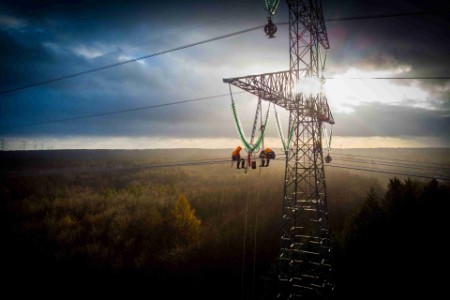The short-term view
Unsurprisingly, the COVID-19 crisis was the main factor affecting prices and demand in the UK power market for much of last year. However, despite unprecedented turbulence in the first half of 2020 because of the pandemic, our winter power market outlook for UK shows that demand remained resilient overall last year. After a 15% drop during the UK-wide lockdown from March 2020, demand had returned to 2019 levels by October. The pace of recovery achieved in power demand has increased our outlook for short-term power demand versus our previous Q2 2020 summer outlook.
A significant source of uncertainty for the market was also resolved late last year by the UK-EU trade agreement, adopted ahead of the end of the UK’s transitional phase of Brexit. Our outlook assumes that a negotiated Brexit outcome bolsters the value of sterling (dampening commodity prices), while supporting prospects for a macroeconomic recovery after the COVID-19 crisis.
The EWP provided long-awaited clarity by about the future of carbon pricing post-Brexit by confirming the launch of a UK Emissions Trading System (ETS) from 1 January 2021. The UK ETS creates opportunity for the UK to diverge from the EU ETS in its carbon pricing, creating greater potential for interconnectors to arbitrage between UK and EU markets. However our expectation is that the UK will initially seek to calibrate the volume of allowances attempting to mirror EU ETS prices.
Despite the faster-than-expected demand recovery in 2020 discussed previously, Brexit and COVID-19-related economic uncertainty is likely to remain a significant challenge for the UK power market in the coming year. However, the UK-EU trade deal and a fast COVID-19 vaccine rollout will bolster economic sentiment and enable an exit from the current national lockdown, supporting growth in electricity demand and improving the investment climate for new-generation technologies. This will set the scene for our longer-term view of the UK power market.
Changing price picture
While power price growth will be fuelled by post-COVID-19 demand recovery and increasing gas and carbon costs through the early 2020s, our modelling shows that it will be stemmed from 2026 as the three-gigawatt (GW) Hinkley Point C project comes online.
We see nuclear maintaining a steady baseload presence in the UK power mix to 2050, with the commissioning of a further 6GW of new nuclear generation. This view is supported by the EWP, which commits to bringing at least one large nuclear power station (expected to be Sizewell C in Suffolk, England) to Final Investment Decision stage by the end of the current parliament (May 2024), and provides innovation funding for the development of advanced modular reactor technologies for deployment further out.
Average annual prices are projected to continue to increase from 2032, driven by growth in gas and carbon prices, the retirement of the ageing nuclear fleet, and increasing power demand. However, a tipping point will be reached by the 2040s, when power prices will start to trend lower as renewables increasingly dominate the market.
The long-term growth of wind
Wind deployment is the major growth story for long-term UK power generation in our long-term market outlook. The EWP restates the Government’s plan to achieve 40GW of offshore wind by 2030, including 1GW of floating capacity. In addition to the current 11.5GW of installed offshore, and a further 9GW already procured, CfD Allocation Round 4 – due to be held in Q4 2021 – aims to secure another 12GW of offshore wind towards this 40GW total, potentially doubling the rate of new renewable deployment achieved in Allocation Round 3.
Our analysis shows offshore and onshore resources together will be able to meet more than half of all electricity demand by the early 2030s. By 2050, we forecast offshore wind capacity will reach 70GW, supplying more than half of the UK’s power demand that year.
Demand electrification
The dramatic increase in renewable generation envisaged in our power market outlook will also facilitate the decarbonisation of the heat and transportation sectors. We expect total system power demand to increase by 70% between 2020 and 2050, driven by greater use of electric heat pumps and continued uptake of electric vehicles (EVs). Our assumed ambitious projections for the latter were supported by a surge in sales last year, with EVs accounting for 5% of new cars sold in 2020 compared with 2% in 2019.
The development of green hydrogen, which requires renewable electricity for production, will also contribute to our expectations of a 70% increase in power demand. However, the role of green hydrogen depends on significant technological innovation driving down the current steep cost of electrolysers. We believe this is possible in light of the EU’s green-hydrogen strategy, which promises an EU-wide commitment to its deployment.
In the UK, the current Government’s aim is for 5GW of low-carbon hydrogen capacity to be developed by 2030, producing 42 terawatt hours of hydrogen annually. While a Net Zero Hydrogen Fund will provide £240m (US$320m) in capital co-investment to such projects over the next five years, further detail of the regulatory framework for incentivising hydrogen uptake is expected in a UK hydrogen strategy to be published by early 2021.
Much of the detail around how the Government’s latest policies and targets will be delivered remains to be seen. Consideration should also be given to whether further intervention is necessary to incentivise the flexibility that a fully decarbonised power system will need in future. However, our latest analysis shows the transformation in store for the UK power market as it adapts to major changes to supply and demand in line with the energy transition.


